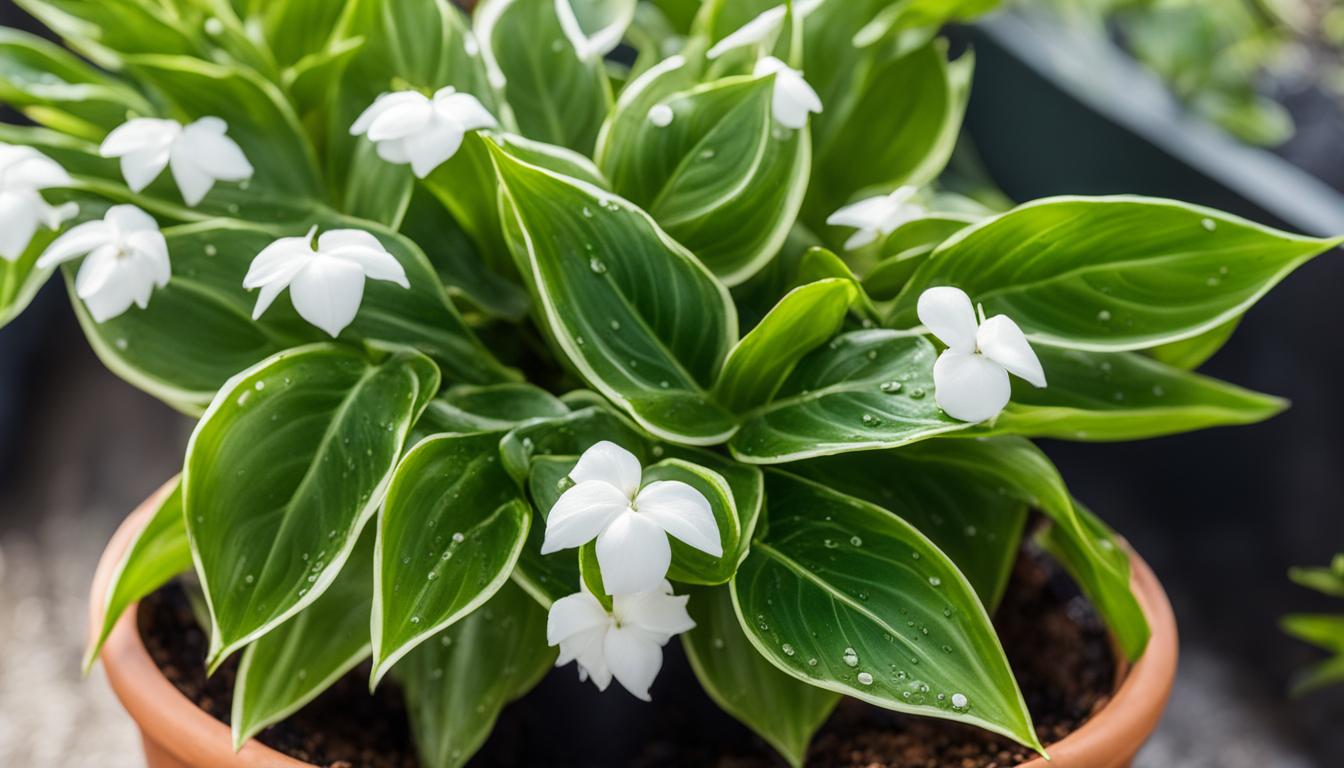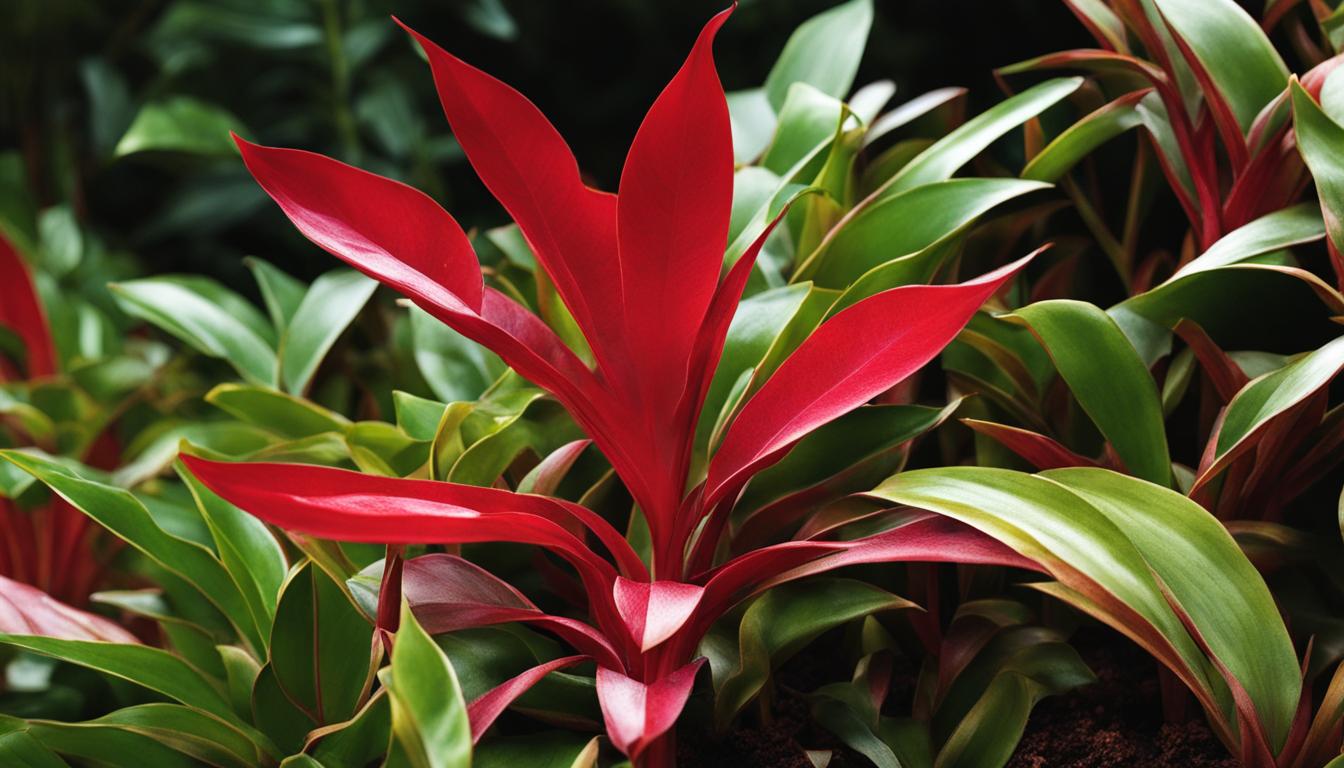Welcome to the Tropic Snow Care Guide! Whether you have a tropical snow plant or a dieffenbachia, I’m here to provide you with all the tips and information you need to keep your plants happy and thriving. Caring for these green beauties can be a rewarding experience, and with the right knowledge, you’ll be able to provide the proper care and maintenance they require.
A lush green tropical plant with snow-like white flowers, surrounded by moisture-rich soil in a vibrant pot. The plant has healthy, glossy leaves and visible drops of water on its petals, indicating proper watering. In the background, a bright sunny day showcasing natural light shining on the plant.
Key Takeaways
- Tropic snow plants require specific care and maintenance to thrive.
- Understanding proper drainage and watering techniques is essential for standard planter care.
- Self watering planters should be used with caution and specific instructions should be followed.
- Dieffenbachia has its own care requirements, including watering frequency, light preferences, and repotting.
- Recommended accessories and plant care guides can help enhance the growth of your tropic snow plants.
Standard Planter Instructions for Tropic Snow Plants
When it comes to caring for your tropic snow plants in standard planters, it’s essential to follow proper drainage and watering techniques. To ensure optimal growth and health for your plants, here are some standard planter instructions to keep in mind:
- Drainage: Place a layer of drainage material, such as small rocks or pebbles, at the base of the planter. This helps facilitate oxygen flow to the plant’s roots and prevents waterlogging.
- Watering: Water your tropic snow plant once a week, allowing the soil to dry out slightly between waterings. Be sure to water thoroughly until water drains out of the bottom of the planter.
- Plant Saucer: Use a plant saucer underneath the planter to collect any excess water that drains out. This prevents water from pooling on your surfaces and protects your plant from sitting in standing water.
- Watering Frequency: The watering frequency may vary depending on factors such as humidity and temperature. Use a soil probe to test the moisture content of the soil before watering again.
By following these standard planter instructions, you can create the ideal conditions for your tropic snow plants to thrive and flourish.
Creating a nurturing environment for your plants will ensure their long-term health and beauty.
| Watering Frequency | Light Requirements | Soil Type |
|---|---|---|
| Once a week | Medium to bright indirect light | Well-draining soil |
| Varies based on climate | Partial shade to bright indirect light | Loose, well-aerated soil |
Self Watering Planter Instructions for Tropic Snow Plants
When it comes to caring for your tropic snow plants, using self watering planters can be a convenient and efficient option. These planters provide a steady supply of water to your plants, allowing them to drink at their own pace and ensuring proper moisture levels. It’s essential to follow specific instructions to maximize the benefits of self watering planters and keep your tropic snow plants healthy and thriving.
Top Watering vs. Reservoir Servicing
One important aspect of self watering planters is to avoid top watering. Instead of pouring water directly onto the soil surface, self watering planters have a reservoir at the bottom that stores water for the plants to draw from. Top watering can lead to uneven moisture distribution and may result in root rot or other plant health issues. By allowing the plants to drink from the reservoir, you promote healthier growth and minimize the risk of overwatering.
Watering Frequency and Soil Moisture
The frequency of watering your tropic snow plants in self watering planters will depend on various factors such as the size of the planter, environmental conditions, and the specific needs of your plants. It’s recommended to monitor the soil moisture regularly using soil moisture probes or by checking the moisture level manually. Refill the reservoir once it has emptied completely, and avoid topping up the water before that to ensure a proper drying out period for the plants.
Aeration Stones for Proper Drainage
To promote healthy root growth and prevent waterlogging in self watering planters, it’s advisable to use aeration stones. These stones create air pockets within the soil, facilitating oxygen flow to the roots and allowing excess water to drain effectively. Aeration stones also help to prevent soil compaction and maintain optimal moisture levels, ensuring a healthy environment for your tropic snow plants.
Related article: The Complete Guide to Indoor Plant Care for Beginners
By following these self watering planter instructions, you can provide the ideal conditions for your tropic snow plants to thrive. Remember to avoid top watering, monitor the watering frequency and soil moisture, and use aeration stones for proper drainage. With the right care and attention, your tropic snow plants will flourish and bring beauty to your indoor or outdoor space.
Tropic Snow Plants Care Guide
The dieffenbachia, also known as the tropical snow plant, requires specific care to thrive and stay healthy. By following these care instructions, you can ensure that your dieffenbachia plant remains vibrant and beautiful.
Watering Frequency
Proper watering is essential for the dieffenbachia’s well-being. Water your plant once per week or every two weeks, allowing the top inches of soil to dry out before watering again. Overwatering can lead to root rot, so it’s important to find a balance. Use your finger to check the soil moisture level before watering.
Light Requirements
The dieffenbachia prefers medium levels of indirect light. Avoid placing it in direct sunlight, as it can scorch the leaves. Place your plant in a location where it can receive bright, filtered light throughout the day. If you notice the leaves becoming pale or yellow, it may indicate that the plant is getting too much light.
Temperature and Humidity
The ideal temperature range for dieffenbachia plants is between 60°F and 75°F (15°C – 24°C). Avoid exposing the plant to temperatures below 60°F (15°C) or drafts, as it is sensitive to cold. Additionally, the dieffenbachia thrives in high humidity environments. You can increase humidity by placing a tray of water near the plant or using a humidifier.
Soil Type and Repotting
Dieffenbachia plants prefer well-draining soil to prevent waterlogged roots. Use a well-balanced potting mix or create a mixture of equal parts peat moss, perlite, and potting soil. Repot your dieffenbachia every 2-3 years, or when it becomes root-bound. Choose a pot that has drainage holes to allow excess water to escape.
Pest Control and Propagation
Common pests that can affect the dieffenbachia include spider mites, mealybugs, and aphids. Regularly inspect your plant for signs of infestation and treat it immediately to prevent further damage. Propagation of the dieffenbachia can be done through stem cuttings or air layering. Both methods are effective, and you can choose the one that suits you best.
Yellowing Leaves
If you notice the leaves of your dieffenbachia turning yellow, it may indicate various issues, including overwatering, underwatering, insufficient light, or nutrient deficiencies. Check the moisture level of the soil, adjust the watering routine if necessary, and ensure the plant is receiving adequate light. If the issue persists, consider fertilizing the plant with a balanced houseplant fertilizer.
Recommended Accessories for Tropic Snow Plants
When it comes to caring for your tropic snow plants, having the right accessories can make all the difference. These accessories not only enhance the growth and wellbeing of your plants but also make the care process easier and more enjoyable. Here are some recommended accessories that you should consider:
Pot Stands and Trays
Pot stands and trays are practical accessories that can help elevate the look of your tropic snow plants. They come in various designs and materials, allowing you to choose the ones that best complement your plant decor. Pot stands not only provide stability and support for your plants but also help prevent damage to your floors and surfaces. Trays, on the other hand, catch excess water and prevent it from spilling onto your furniture, keeping your space clean and tidy.
Humidity Trays
Tropic snow plants thrive in humid environments, and using humidity trays can help create the perfect conditions for their growth. These trays are filled with water, and as the water evaporates, it increases the humidity around your plants. This is especially beneficial during dry winter months or in dry climates where humidity levels can drop significantly. By using humidity trays, you can mimic the natural environment of tropic snow plants and promote healthy growth.

Tropic Snow Plant Size Chart
When caring for your tropic snow plants, it’s important to understand their potential size and choose the right pot options. The size chart below provides information on recommended pot options, including grower eco pots, eco pot baskets, and ceramic pots. Each option offers unique benefits and aesthetics for your plants.
| Pot Option | Description |
|---|---|
| Grower Eco Pots | These pots are made from recycled materials and have excellent drainage. They are lightweight and come in various sizes, making them suitable for different stages of plant growth. |
| Eco Pot Baskets | These stylish baskets provide a decorative touch to your plants. They are made from eco-friendly materials and have a natural look. The baskets are ideal for larger tropic snow plants that require more space for their roots to spread. |
| Ceramic Pots | Ceramic pots are a classic choice for indoor plants. They come in a wide range of sizes and colors, allowing you to find the perfect pot to match your home decor. Ceramic pots retain moisture well and provide stability for your tropic snow plants. |
When selecting a pot, consider the size of your plant and its growth potential. It’s important to choose a pot that allows your plant’s roots to develop and has proper drainage to prevent waterlogging. The right pot will provide sufficient space for your tropic snow plant to thrive and beautify your living space.
It’s worth noting that tropic snow plants are toxic if ingested, so take precautions if you have pets or small children. Keep your plants out of reach or choose a safe location where they cannot be accessed by curious hands or paws.
Conclusion
In conclusion, the care and maintenance of tropic snow plants are of utmost importance for their overall health and wellbeing. By following the guidelines provided in this care guide, you can ensure that your plants thrive and bring joy to your space.
Understanding the specific watering, light, and temperature requirements of your tropic snow plants is essential. Providing them with the proper amount of water and light will help them grow strong and vibrant. Additionally, selecting the right pots and accessories, such as drainage systems and plant saucers, will contribute to their overall health.
Remember, the well-being of your tropic snow plants is in your hands. By giving them the care and attention they need, you can experience the joy of having happy and thriving plants in your home or outdoor area. So go ahead, take the time to nurture your green beauties, and watch them flourish!
FAQ
What are the standard planter instructions for tropic snow plants?
Standard planter instructions recommend using a layer of drainage at the base of the planter and using a plant saucer to collect excess water. Watering should be done once a week, and the moisture content of the soil can be checked using a soil probe.
How do I care for tropic snow plants in self-watering planters?
After the initial top water period, the reservoir should be filled and the plant should be allowed to drink from it. The reservoir should be allowed to empty completely before refilling. Top watering should be avoided, and the moisture content of the soil can be monitored using soil moisture probes. Aeration stones should be used for proper drainage.
What are the care requirements for dieffenbachia?
Dieffenbachia should be watered once per week or every two weeks, allowing the top inches of soil to dry out before watering again. It prefers medium levels of indirect light and thrives at temperatures between 60°F and 75°F. Dieffenbachia should be kept in well-draining soil, repotted every 2-3 years, and placed in a pot with drainage holes. Common pests include spider mites, mealybugs, and aphids. Propagation can be done through stem cuttings or air layering. Yellowing leaves may indicate unhappy plant conditions.
What accessories are recommended for tropic snow plants?
Recommended accessories include plant care guides for various plants such as aglaonema, alocasia, anthurium, bird’s nest fern, cactus, calathea, and more. These guides provide specific care instructions tailored to each individual plant.
How do I determine the size of my tropic snow plants?
The tropic snow plant size chart provides information on recommended pot options, including grower eco pots, eco pot baskets, and ceramic pots. Various color options are available as well.



